|
|
|
WESTPEX® 2024 |
|||||||||||||||||||||||
|
Stamp Show |
|||||||||||||||||||||||
|
WESTPEX Discovers Gold WESTPEX is the largest and most successful stamp show held west of the Mississippi. For 48 years WESTPEX has been the place on the west coast where stamp collectors and dealers from all over the world meet to show, buy, sell and talk philately. WESTPEX 2008 will be held April 25-27 at the San Francisco Airport Marriott Hotel. The main show is preceded by a Collectors Club of San Francisco dinner on April 23th and an APS seminar on the Washington Franklin Issues on the 23th and 24th. In recent years its been WESTPEX's custom to theme its show around a local history anniversary. The 2006 show remembered the San Francisco earthquake while 2007 honored Emperor Norton I, an unparalleled local celebrity. This year WESTPEX is commemorating the 160th anniversary of the discovery of gold in California. The show's souvenir sheet displays trade cards from clipper ships of the gold rush era. |
|||||||||||||||||||||||
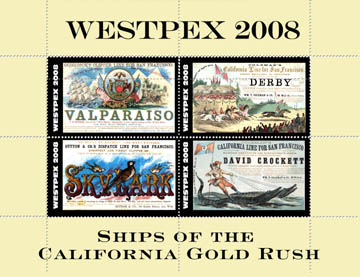 |
|||||||||||||||||||||||
 |
|||||||||||||||||||||||
|
This sheet is available for $5 plus $1 postage from the show web site at westpex.com or by mail from WESTPEX, Order Desk, P.O. Box 210579, San Francisco, CA 94121. The trade card for the ship David Crockett has also been made into a colorful pin which is available for $5 plus $1 postage from the above sources. |
|||||||||||||||||||||||
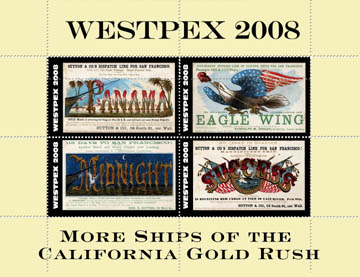 |
|||||||||||||||||||||||
|
A second souvenir sheet, More Ships of the California Gold Rush, is a private issue available only to show volunteers and other friends of WESTPEX. A Brief History of California's Gold Rush Gold was discovered on January 24, 1848, by James Marshall at a saw mill in Coloma, California which was being built for John Sutter. Interestingly, Sutter endeavored to keep the discovery secret and in the interim (February 2, 1848) the treaty of Guadalupe Hidalgo is signed by Mexico selling California (and other Mexican lands) to the United States. By March of 1848, gold has also been found on the South Fork of the American River, and at the end of March the first reports of the discovery of gold are appearing in California newspapers. |
|||||||||||||||||||||||
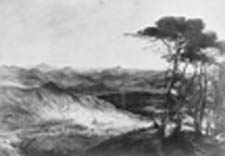 |
|||||||||||||||||||||||
|
In May, Samuel Brannan, a storekeeper at Sutter's Fort and the publisher of a newspaper, The California Star stirs up excitement about gold by running up and down the streets of San Francisco shouting "Gold! Gold! Gold! From the American River". He sells 2000 copies of a special edition of The California Star. It takes until August of 1848, for the New York Herald to publish a story about the discovery of gold. Interestingly, it's also not until August that the end of the Mexican war and acquisition of California from Mexico, is reported. News was clearly slower then! By October, the steamship California, the premiere ship of the Pacific Mail Steamship Company, left New York for California. Gold seekers don't ship out of New York for California until November of 1848. On April 1, 1849, the steamship California arrives with the first mail. By this time Sutter's Mill has attracted crowds of Chilean, Mexican and Peruvian immigrant gold seekers who are periodically driven away by vigilantes. Also in April 1849, the first wagon trains depart Missouri and Iowa for California. In May the sailing ship Grey Eagle with 34 passengers arrives after a 113 day journey around the Horn. By June, The Pacific Mail Steamship Company has set up runs from the west coast of Panama to San Francisco. By June 1849, the three major routes for American gold seekers are established. Those with little money bought a wagon and supplies, joined a wagon train and made an arduous five month overland journey. At the end of the trip they could recoup some of their investment by reselling the wagon and any remaining oxen. Folks with lots of money and an appetite for risk took steamships or clippers from New York to Panama and crossed the isthmus overland picking up another ship on the west coast for the final leg to San Francisco. This was the fastest route but the land portion was a pretty miserable journey with significant disease risks. In the middle of the economic and risk spectrum were those who booked passage on the clipper ships, the great transportation sensation of their day. A Brief History of Clipper Ships John Lienhard of the public radio show "The Engines of Our Ingenuity" says "clipper ships were not a specific design; they were a state of mind. And that state of mind lasted only a decade." Until 1845, capacity was more important than speed for the movement of cargo by ship. Ships had high capacity and low speed. Two factors, the development of San Francisco as a profitable port (even before the discovery of gold) and the tea trade stood this balance on its head. In America, clippers were first notable for their ability to run blockades during the War of 1812 although the first "clipper" in the U.S. was the Baltimore Clipper, a topsail schooner built before the American Revolution. Clippers were built for high-value seasonal trades in tea and spices and for relatively fast passenger transport. Speed competition amongst clippers was highly newsworthy. The trade cards shown on WESTPEX's souvenirs for 2008 represented the first significant use of color in American advertising. Although clippers provided significant transport to the gold rush the color trade cards actually came several years later when the demand for clipper transportation had fallen off. During the height of the gold rush, handbills and notices in the newspaper were sufficient to fill the ships. The decline of the clippers came with the Panic of 1857 and the gradual introduction of the steamship. While clippers were faster than the early steamships, they depended on unpredictable winds and weather so the steamships were more reliable.. |
|||||||||||||||||||||||
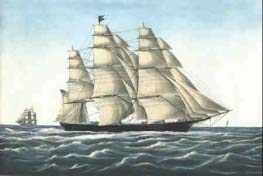 |
|||||||||||||||||||||||
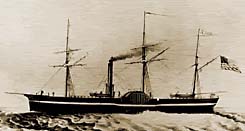 |
|||||||||||||||||||||||
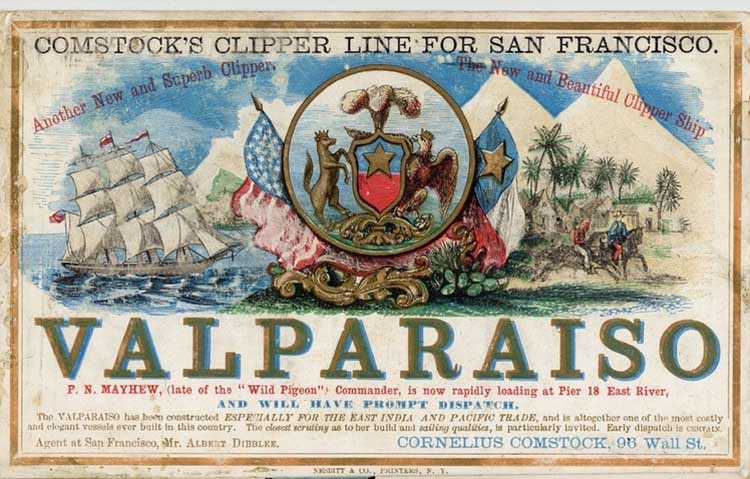 |
|
What's of Interest Here to Philatelists The California gold rush appears just at the end of the first decade of stamp usage and a time when mail services were in ever increasing demand. Routes from Elsewhere Mail came to San Francisco and the gold country from the rest of the world exclusively by sea. Although many gold seekers came to California overland, mail wasn't carried that way until after 1857. Sea routes ran around the Cape, across the Isthmus of Panama and across Nicaragua, a shorter, easier transit than that across Panama. By 1855, the Panama railway began to replace all other east to west routes. Service within California A post office was established in San Francisco on November 9, 1848. More government post offices were slow to arrive so local express companies were started to take up the slack. Alexander Todd couldn't stomach life as a miner so he established the first California express line of consequence taking letters and parcels from the mines to San Francisco and back. Within a few months he had over 2000 subscribers who paid a dollar to sign up and four dollars per letter received! For shipments of gold, usually in the form of gold dust, he received 5% of the value of the shipment. Wells Fargo, the most famous California express company didn't start until 1852 and the company didn't become dominant in California until the failure of Adam's Express in 1855. Well's Pony Express didn't come along until 1862 long after the gold rush was ended. Philatelic Books about the Discovery of Gold Philately is blessed with several excellent books about the connection of postal history, and the various gold discoveries all written by a Canadian mining engineer, Kenneth Kutz. His first book, Gold Fever, was published in 1988 and received a Grand Award at the Orapex Literature Exhibition (Ottawa). He followed that book with Nome Gold, Victoria Gold, Klondike Gold and most relevantly here, California Gold |
|||
|